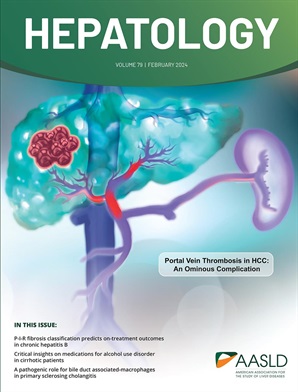Aging disrupts hepatocyte zonation homeostasis in mice and humans
IF 12.9
1区 医学
Q1 GASTROENTEROLOGY & HEPATOLOGY
引用次数: 0
Abstract
Background and Aims: Aging-induced degenerative changes in the liver are not inherently pathologic but pose an increased risk for liver diseases. However, the molecular mechanisms underlying aging-induced hepatic dyshomeostasis remain incompletely characterized. Here, we investigate how aging alters liver architecture, cellular communication, and hepatocyte zonation. Approach and Results: Histological analyses of aged (>24-month-old) wild-type mouse livers showed no fibrosis, but a uniform cellular enlargement compared to young (2-month-old) mouse livers. For an unbiased characterization of aging-driven changes, we used single-nucleus RNA sequencing and found that aged livers had altered cell-cell interactions and hepatocyte zonation with zone-specific transcriptomic changes. Immunostaining confirmed aging-induced expansion of ASS1衰老破坏了小鼠和人类肝细胞分区的稳态
背景和目的:衰老引起的肝脏退行性改变本身不是病理性的,但会增加肝脏疾病的风险。然而,衰老引起的肝脏失衡的分子机制仍然不完全清楚。在这里,我们研究衰老如何改变肝脏结构、细胞通讯和肝细胞分区。方法和结果:老龄(24个月大)野生型小鼠肝脏的组织学分析显示,与幼龄(2个月大)小鼠肝脏相比,老龄(24个月大)野生型小鼠肝脏没有纤维化,但有均匀的细胞增大。为了不偏不倚地描述衰老驱动的变化,我们使用了单核RNA测序,发现衰老的肝脏改变了细胞-细胞相互作用和肝细胞分区,并发生了区域特异性转录组变化。免疫染色证实了衰老诱导的ASS1+、CYP2E1+和GS+肝区扩大,以及ASS1+-GS+“双区”肝细胞的异常表达,导致明显的区分丧失。从机制上讲,这种破坏与关键分区调节因子(Ctnnb1, fox01, Tcf7l2)的下调以及NPCs中Wnt和Rspo3信号的代偿性改变有关。为了评估翻译相关性,对年轻(≤25岁)和老年(≤60岁)人类供体的肝脏活检进行了分析,揭示了类似的区域改变,并支持这些衰老相关表型在物种间的保护。结论:这些发现表明,衰老会导致明显的肝分区丧失,并通过肝细胞类型的广泛转录和结构重塑改变细胞间通讯。双区肝细胞的出现和肝区在老年肝脏中的扩张是肝脏衰老的关键标志。我们的研究为肝脏衰老的机制提供了新的见解,并可能为针对年龄相关肝功能障碍的治疗策略提供信息。
本文章由计算机程序翻译,如有差异,请以英文原文为准。
求助全文
约1分钟内获得全文
求助全文
来源期刊

Hepatology
医学-胃肠肝病学
CiteScore
27.50
自引率
3.70%
发文量
609
审稿时长
1 months
期刊介绍:
HEPATOLOGY is recognized as the leading publication in the field of liver disease. It features original, peer-reviewed articles covering various aspects of liver structure, function, and disease. The journal's distinguished Editorial Board carefully selects the best articles each month, focusing on topics including immunology, chronic hepatitis, viral hepatitis, cirrhosis, genetic and metabolic liver diseases, liver cancer, and drug metabolism.
 求助内容:
求助内容: 应助结果提醒方式:
应助结果提醒方式:


